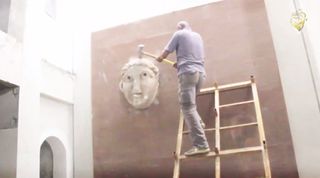Ancient Mesopotamian Artifacts Smashed in New ISIS Video

To the horror of archaeologists and history buffs around the world, militants with the extremist group ISIS released a new video today (Feb. 26) that shows ancient Mesopotamian sculptures and other artifacts being smashed inside northern Iraq's Mosul Museum.
The destruction — which comes weeks after ISIS deliberately destroyed library collections in Mosul — is part of an ongoing effort by ISIS militants to get rid of objects and structures they consider idolatrous, whether that means obliterating archaeological relics or demolishing Sufi shrines.
According to a translation by The New York Times, a man shown in the video says, "The prophet, peace be upon him, ordered us to remove and obliterate statues. And his companions did the same, after him, when they conquered countries." [In Photos: Treasures of Mesopotamia]
The Mosul Museum was considered "the most important museum in Iraq outside of the Iraqi National Museum," according to a 2009 UNESCO assessment of the site.
At the Metropolitan Museum of Art in New York City, director Thomas Campbell strongly condemned the destruction in Mosul, calling for an end to such "wanton brutality."
"This mindless attack on great art, on history and on human understanding constitutes a tragic assault not only on the Mosul Museum, but on our universal commitment to use art to unite people and promote human understanding," Campbell said in a statement.
Suzanne Bott became familiar with the Mosul Museum when she spent 2008-2010 in the Iraqi city as a cultural heritage reconstruction advisor with the U.S. State Department. Bott, who now works at the University of Arizona, told Live Science that she believes most of the artifacts shown in the video were authentic.
Sign up for the Live Science daily newsletter now
Get the world’s most fascinating discoveries delivered straight to your inbox.
Many of the more valuable objects in the Mosul Museum had been moved to Baghdad for security reasons during the Iraq War, Bott said, but a lot of the heavier sculptures and artifacts were left behind. The museum hasn't been open to the public for a long time due to ongoing conflicts, but Bott said she visited numerous times to help with repairs and collection maintenance.
Bott said some of the artifacts in the video appeared to have been from the fortified ancient city of Hatra — a UNESCO World Heritage Site in Iraq that dates back to the 3rd century B.C. (and famously appeared in the opening scene of "The Exorcist"). The clip also showed militants using power tools to destroy the colossal winged bull statues that stand guard at the Nergal Gate Museum at Nineveh, the ancient Assyrian capital near Mosul.
"There's certainly no comparison to the loss of human life," Bott said, "but I think ISIS has done irreparable harm to the knowledge and information we have been able to gain about our ancestors and the earliest civilizations. It's done through ignorance."
It's particularly painful when that destruction takes place in Mesopotamia, the backdrop for some of "the earliest leaps forward" in astronomy, medicine, law, commerce and agriculture, Bott said.
Follow Megan Gannon on Twitter. Follow us @livescience, Facebook & Google+. Original article on Live Science.

